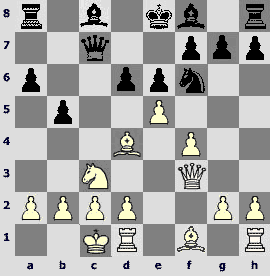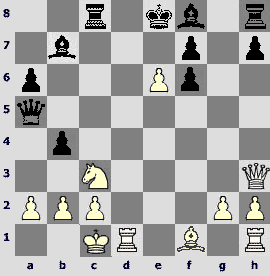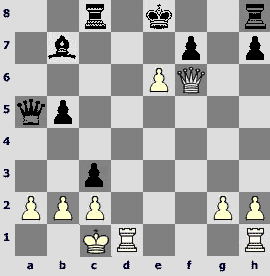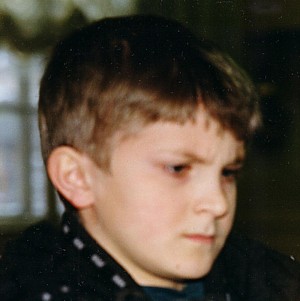05.04.2005
PEN OF A WUNDERKIND: 11-year-old Nikita Vitiugov
Vitiugov N. – Kim A.
Championship of Russia U12
A game that will be discussed below was played in 1998 at the championship of Russia U12 in Orel. The author of these lines had spent the most part of the tournament in the pelothon, but by the last circle reached table 4 and played a game against a Muscovite Alexei Kim. A draw was almost out of question, as the win provided a shared third place. That`s why Black's play was so risky.
1.e2-e4 c7-c5 2.¤g1-f3 e7-e6 3.¤b1-c3 ¤b8-c6 4.d2-d4 c5xd4 5.¤f3xd4 Јd8-c7 6.f2-f4
The opening is quite aggressive (6.Ґc1-e3 is calmer)
6...d7-d6 Rejecting the Paulsen (6...a7-a6!?)
7.Ґc1-e3 ¤g8-f6 8.Јd1-f3 a7-a6 (Five years later a Ukrainian grandmaster executed an instructive punishment to your obedient servant, who had chosen another continuation 8...Ґf8-e7 9.0-0-0 0-0 10.g2-g4 ¤c6xd4 11.¦d1xd4 a7-a6 12.g4-g5 ¤f6-d7 13.h2-h4 b7-b5 14.Ґf1-h3 ¦a8-b8 15.h4-h5 b5-b4 16.¤c3-e2 ¤d7-c5 17.ўc1-b1 Ґc8-b7 18.f4-f5 ¦f8-c8 19.¦h1-c1 e6-e5 20.¦d4-c4 d6-d5 21.e4xd5 e5-e4 22.Јf3-g3 Ґe7-d6 23.¤e2-f4 Јc7-a5 24.g5-g6 Ґb7xd5 25.g6xh7+ ўg8xh7 26.f5-f6 1-0 Zontakh,A-Vitiugov,N/St Petersburg,2003)
9.0-0-0 ¤c6xd4 10.Ґe3xd4 b7-b5 11.e4-e5

An interesting move that obliged both parties to act extremely accurately, besides it was a novelty by that moment. However, according to my database, nobody has played this way since that game.
(11.g2-g4)
(11.Ґf1-d3)
( 11.a2-a3 Ґc8-b7 12.g2-g4 ¦a8-c8 13.Ґf1-d3 d6-d5 14.e4-e5 ¤f6-e4 15.¤c3-e2 b5-b4 16.a3xb4 Ґf8xb4 17.f4-f5 0-0 18.ўc1-b1 f7-f6 19.Јf3-f4 f6xe5 20.Ґd4xe5 Јc7-b6 21.Ґd3xe4 d5xe4 22.¦d1-d7 1-0 Kozlov,V-Chudinovskih,A/Simferopol 1989)
11...Ґc8-b7 12.Јf3-h3 Preparing to supportf5 (12.Јf3-g3 is less in the spirit of the position: 12...¤f6-e4 13.¤c3xe4 Ґb7xe4 14.Ґf1-d3 Ґe4xd3 15.¦d1xd3 d6-d5
A) 16.¦h1-d1 b5-b4 17.ўc1-b1 g7-g6 18.c2-c3∞;
B) 16.f4-f5 e6xf5 17.Јg3-g5 ¦a8-c8 18.¦d3-c3 (18.c2-c3 Јc7-d7 19.¦h1-f1 b5-b4 20.Јg5xf5 Јd7xf5 21.¦f1xf5 b4xc3 22.Ґd4xc3 Ґf8-b4=) 18...Јc7-d7 19.¦c3xc8+ Јd7xc8 20.¦h1-f1 h7-h6=;
C) 16.¦h1-f1 g7-g6 17.a2-a3 Ґf8-e7;
D) 16.¦d3-c3
D1) Passive 16...Јc7-d7?! 17.¦h1-d1 is worse (17.Ґd4-c5? b5-b4; 17.f4-f5?! e6xf5 18.¦h1-f1 Јd7-e6∞) 17...¦a8-c8 18.a2-a3ѓ;
D2) 16...Јc7-a5 17.ўc1-b1 b5-b4 18.¦c3-d3 ¦a8-c8 19.f4-f5 Јa5-c7 20.¦d3-d2 e6xf5 21.Јg3-d3 (21.Јg3-g5 Јc7-d7 22.¦h1-f1 Јd7-e6 23.Јg5xf5 Ґf8-e7=) 21...Јc7-c6 22.Јd3xf5 Јc6-e6∞)
12...d6xe5
(12...¤f6-e4?! Is weaker
A) 13.¤c3xe4!? Ґb7xe4 14.Ґf1-d3 Ґe4xd3 15.¦d1xd3 d6-d5 16.f4-f5ѓ;
B) 13.e5xd6? Ґf8xd6! (13...¤e4xd6?! 14.Ґf1-d3) 14.Ґd4xg7 ¤e4-f2 15.Јh3-h4 ¤f2xd1 16.Ґg7xh8 ¤d1xc3 17.Ґh8xc3 Ґb7-e4ѓ;
C) 13.Ґf1-d3! 13...d6-d5 (13...¤e4xc3?! 14.Ґd4xc3 d6-d5 15.f4-f5ѓ) 14.f4-f5! (14.Ґd3xe4 d5xe4 15.Јh3-e3 ¦a8-c8„) 14...e6xf5 15.Јh3xf5 g7-g6 16.Јf5-g4 ¤e4xc3 17.Ґd4xc3±)
13.Ґd4xe5 Јc7-a5? Where did the black queen go? This demonstration of pseudoactivity will finally do Black (Necessary is13...Јc7-c6! 14.a2-a3 ¦a8-c8„)
14.f4-f5! The position of Black already raises grave misgivings.
14...b5-b4? Black dives into the vortex(14...Јa5-b6 15.Ґe5xf6 g7xf6 16.f5xe6 f7xe6 17.Ґf1-e2±)
15.Ґe5xf6 g7xf6 (15...b4xc3 16.Ґf6xc3
A) 16...Јa5xa2 17.f5xe6 f7xe6? (17...Јa2-a1+ 18.ўc1-d2 Јa1-a2 19.b2-b3!±) 18.Ґf1-b5+ a6xb5 19.Јh3-h5+ g7-g6 20.Јh5xb5++-;
B) 16...Јa5xf5 17.Јh3xf5 e6xf5 18.Ґf1-d3 Ґf8-e7 19.¦h1-e1 ўe8-f8 20.Ґd3xf5+-)
16.f5xe6 ¦a8-c8

(16...b4xc3? 17.e6xf7+ ўe8xf7 18.¦d1-d7+ ўf7-g6 (18...Ґf8-e7 19.Ґf1-c4+ ўf7-e8 20.¦d7xe7++-) 19.Ґf1-d3+ f6-f5 20.¦h1-f1+-; 16...Јa5-g5+!? 17.ўc1-b1 Ґf8-e7 18.e6xf7+ ўe8-f8 19.Јh3-d7!± allowed to hold out somehow)
17.Ґf1-b5+!A nice interposition
(17.e6xf7+ ўe8xf7 18.Јh3-d7+ Ґf8-e7 19.¦d1-e1 in White's favour)
(17.e6-e7 Ґf8xe7 18.Јh3-d7+ ўe8-f8 19.Јd7xb7 ¦c8-c7 20.¦d1-d5 ¦c7xb7 21.¦d5xa5 b4xc3 22.b2-b3 ¦b7-b6 23.Ґf1xa6 ¦h8-g8 24.g2-g3±)
17...a6xb5 18.Јh3-h5?Even now I blush when remember that I didn't even consider a trite18.ef7+. "Nobody is perfect..." (18.e6xf7+! ўe8xf7 19.Јh3-h5+ ўf7-g8 20.¦d1-d7)
18...Ґf8-h6+!?Quite resourceful, and what is more important unexpected (18...¦c8-c7 19.e6xf7+ ¦c7xf7 20.¤c3xb5+-)
19.Јh5xh6 b4xc3 20.Јh6xf6?

How to annotate these moves? The last round, the nerves are strained, the lack of skill had to be compensated only with desire and motivation... Having obtained a completely won position White starts making mistakes at every step. For example White overlooked the castling - the author thought for some reason that Black can not castle as White attacked the rook. In my defense I can remember a situation when Garry Kasparov consulted an arbiter about the possibility of long castling, when his opponent had h7-b1(or h2-b8) diagonal under control. Elementary20.Јh6-g7! c3xb2+ 21.ўc1-b1 ¦h8-f8 22.e6xf7+ ўe8-e7 23.¦h1-e1++- was winning)
20...c3xb2+ 21.ўc1-b1 0-0 22.¦d1-d4 Fortunately, the black king can not find a safe shelter in this game.
22...¦c8-c4 23.e6xf7+?! Having noticed the win of the queen I didn't look for other opportunities, but I should have (after 23.e6-e7! ¦f8-e8 24.¦h1-f1+- Black could resign immediately)
23...¦f8xf7 24.¦d4-d8+ Јa5xd8 25.Јf6xd8+ ўg8-g7 Why did Black hold out for twenty more moves? The answer is simple – White converted the decisive advantage too hesitatingly in the previous part of the game.
26.Јd8-g5+ ўg7-f8 27.Јg5-h6+ ўf8-e7 28.¦h1-e1+ ўe7-d8 29.Јh6-d6+ ¦f7-d7 30.Јd6-f8+ ўd8-c7 31.¦e1-e7 White leaves no chance to the opponent when he exchanges the rooks.
31...¦c4-d4 soon Black resigned.
The annotations S.T. Pinchuk were used
1-0

